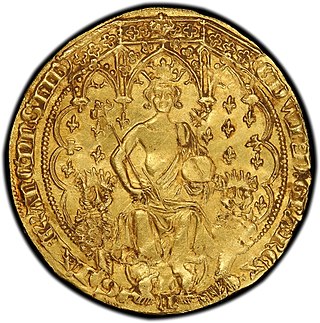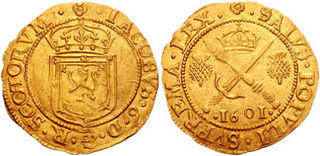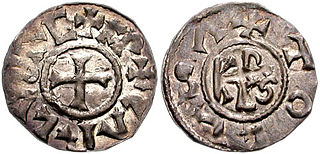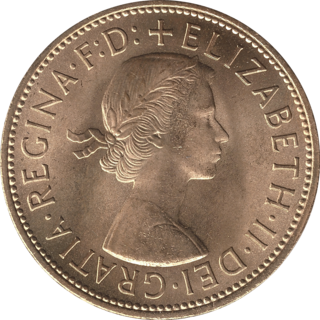
Numismatics is the study or collection of currency, including coins, tokens, paper money, medals and related objects.

A penny is a coin or a unit of currency in various countries. Borrowed from the Carolingian denarius, it is usually the smallest denomination within a currency system. At present, it is the formal name of the British penny (abbr. p) and the de facto name of the American one-cent coin (abbr. ¢) as well as the informal Irish designation of the 1 cent euro coin (abbr. c). Due to inflation, pennies have lost virtually all their purchasing power and are often viewed as an expensive burden to merchants, banks, government mints and the public in general.

The English florin, sometimes known as the double leopard, was an attempt in 1344 by Edward III to produce gold coinage suitable for use in Europe as well as in England. It was authorised on 27 January 1344, and struck from 108 grains of nominal pure ('fine') gold and had a value of six shillings.

The solidus or nomisma was a highly pure gold coin issued in the Later Roman Empire and Byzantine Empire. The early 4th century saw the solidus introduced in mintage as a successor to the aureus, which was permanently replaced thereafter by the new coin, whose weight of about 4.5 grams remained relatively constant for seven centuries.

The pound was the currency of Scotland prior to the 1707 Treaty of Union between the Kingdom of Scotland and the Kingdom of England, which created the Kingdom of Great Britain. It was introduced by David I, in the 12th century, on the Carolingian monetary system of a pound divided into 20 shillings, each of 12 pence. The Scottish currency was later devalued relative to sterling by debasement of its coinage. By the time of James III, one pound Scots was valued at five shillings sterling.

A sceat was a small, thick silver coin minted in England, Frisia, and Jutland during the Anglo-Saxon period that normally weighed 0.8–1.3 grams.

The denier or penny was a medieval coin which takes its name from the Frankish coin first issued in the late seventh century; in English it is sometimes referred to as a silver penny. Its appearance represents the end of gold coinage, which, at the start of Frankish rule, had either been Roman (Byzantine) or "pseudo-imperial". Silver would be the basis for Frankish coinage from then on. The denier was minted in France, Cyprus and parts of the Italian peninsula for the whole of the Middle Ages, in states such as the patriarchate of Aquileia, the Kingdom of Sicily, the Republic of Genoa, the Republic of Siena, Kingdom of Cyprus, and the crusader state Kingdom of Jerusalem, among others.

The history of the English penny can be traced back to the Anglo-Saxon kingdoms of the 7th century: to the small, thick silver coins known to contemporaries as pæningas or denarii, though now often referred to as sceattas by numismatists. Broader, thinner pennies inscribed with the name of the king were introduced to Southern England in the middle of the 8th century. Coins of this format remained the foundation of the English currency until the 14th century.

The shilling, informally called a "bob", was a type of silver coinage issued by the Commonwealth of Australia, that circulated prior to the decimalisation of Australian coinage. The Australian shilling was derived from the British pre-decimal sterling pound system and was first issued following the passing of the Australian Coinage Act 1909, which established Australia's first formal currency system. The shilling was issued as part of Australia's silver coinage, which included the two-shilling (florin), the sixpence and the threepence. The shilling was minted from 1910 until 1963. During this period there was one significant modification to the design of the Australian shilling, the change in its reverse design, which occurred in 1938 when the design was altered from the Australian coat of arms (1910–1936) to the visage of a Merino ram's head (1938–1963).

The British pre-decimal penny was a denomination of sterling coinage worth 1⁄240 of one pound or 1⁄12 of one shilling. Its symbol was d, from the Roman denarius. It was a continuation of the earlier English penny, and in Scotland it had the same monetary value as one pre-1707 Scottish shilling. The penny was originally minted in silver, but from the late 18th century it was minted in copper, and then after 1860 in bronze.

Joe Cribb is a numismatist, specialising in Asian coinages, and in particular on coins of the Kushan Empire. His catalogues of Chinese silver currency ingots, and of ritual coins of Southeast Asia were the first detailed works on these subjects in English. With David Jongeward he published a catalogue of Kushan, Kushano-Sasanian and Kidarite Hun coins in the American Numismatic Society New York in 2015. In 2021 he was appointed Adjunct Professor of Numismatics at Hebei Normal University, China.
Kevin Clancy is a numismatist and the Director of the Royal Mint Museum. Clancy is also Secretary to the Royal Mint Advisory Committee on the Design of Coins, Medals, Seals and Decorations which advises the British Government and Crown on the designs of coins and similar objects.
Peter Spufford, was a British historian and academic, specialising in the economics of Medieval Europe. He was Professor Emeritus of European History at the University of Cambridge.

Viking coinage was used during the Viking Age of northern Europe. Prior to the usage and minting of coins, the Viking economy was predominantly a bullion economy, where the weight and size of a particular metal is used as a method of evaluating value, as opposed to the value being determined by the specific type of coin. By the ninth century, the Viking raids brought them into contact with cultures well familiarised with the use of coins in economies of Europe, hence influencing the Vikings own production of coins.

The Great Bullion Famine was a shortage of precious metals that struck Europe in the 15th century, with the worst years of the famine lasting from 1457 to 1464. During the Middle Ages, gold and silver coins saw widespread use as currency in Europe, and facilitated trade with the Middle East and Asia; the shortage of these metals therefore became a problem for European economies. The main cause for the bullion famine was outflow of silver to the East unequaled by European mining output, although 15th century contemporaries believed the bullion famine to be caused by hoarding.
Silk Road Numismatics is a special field within Silk Road studies and within numismatics. It is particularly important because it covers a part of the world where history is not always clear – either because the historical record is incomplete or is contested. For example, numismatics has played a central role in determining the chronology of the Kushan kings.
Chief Engraver of the Royal Mint is a senior position at the British Royal Mint who is responsible for overseeing the preparation of coin dies.
David Michael Metcalf was a British academic and numismatist. He was the director of the Heberden Coin Room of the Ashmolean Museum, a fellow of Wolfson College and Professor of Numismatics at the University of Oxford. He held the degrees of MA, DPhil and DLitt from Oxford.
Andrew R. Woods is a British numismatist, archaeologist and curator specialising in early medieval and Viking coinage. He is the senior curator of the Yorkshire Museum and was formerly the curator of numismatics at the York Museums Trust.

The Celtic currency of Britain were the various items and coins used as currency between approximately 200 BC and AD 60. The earliest currency consisted of various forms of iron bars. Coins were first imported in large numbers in around 150 BC and domestic minting began around 100BC. Coin production was largely ended by the Roman conquest of Britain, first by the Claudian invasion of AD 43 and later by the Defeat of Boudica in AD 60 or 61. Cast coins may have been produced for a few more years around Hengistbury Head. Exact dating of coins often changes in the light of new research.













